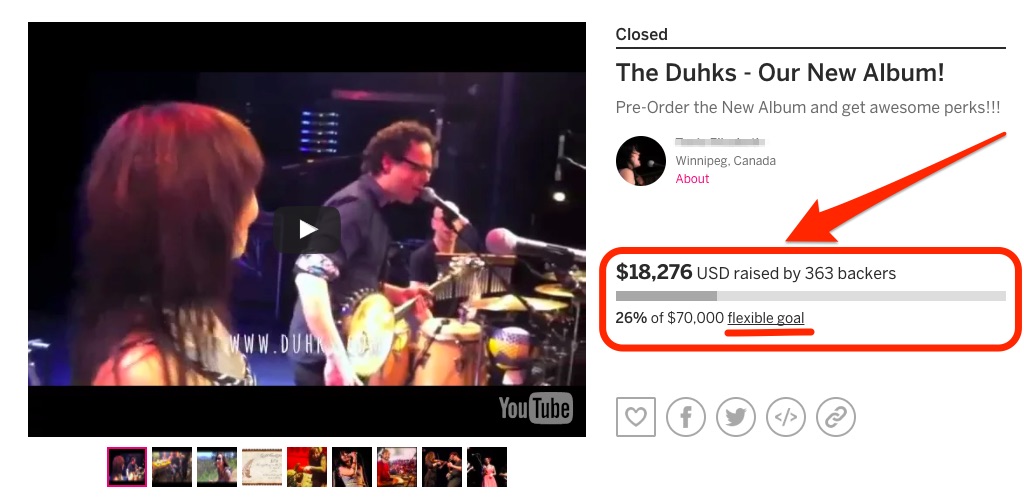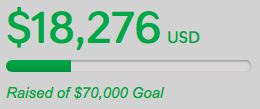 Do you know how much your crowdfunding campaign can raise?
Do you know how much your crowdfunding campaign can raise?
If not, welcome to the club!
Knowing how much you can raise is the biggest unknown in the whole equation.
If you decide to use an all-or-nothing platform like Kickstarter, you may walk away without a dime.
To eliminate this possibility, some people decide to do a Flexible Funding campaign on platforms like Indiegogo or Rockethub where you keep what you raise regardless of whether you hit your goal amount.
It seems like a good idea because you don’t risk walking away empty handed.
But is flexible funding a good idea in artistic crowdfunding genres like music, film, writing, art, food, crafts, etc.?
Well, nothing comes for free…
The cost of minimizing your downside (walking away with nothing) may unknowingly be that you decrease your upside potential (how much you raise if you do everything right).
Consider this comparison of Kickstarter vs. Indiegogo which found that under 10% of Indiegogo campaigns raise 100% of their goal or higher. And potentially worse, only 20% of campaigns reach even 25% of their goal.
That’s pretty grim.
But before I give you 7 Ways Flexible Funding Lowers How Much Your Crowdfunding Campaign Can Raise, let’s take a look at a real-world flexible funding project that admits their flex-funding approach hurt them.
Flexible Funding Screwed The Duhks
The Duhks are a country/roots/folk/Americana’ish band that has had decent national success in the US and Canada over the last decade. They tour all over both countries, get some radio play and have been nominated for multiple Juno’s (Canada) and even a Grammy in 2007.
The goal for their Flexible Funding Indiegogo campaign was $70,000.
Turns out they only hit just north of $18,000.
 Based on what the Duhks’ say in their campaign description, they view this as a success.
Based on what the Duhks’ say in their campaign description, they view this as a success.
Even though we haven’t reached our goal of $70,000, we are doing GREAT. We are finding alternative ways of making things happen, and everything is falling into place beautifully.
Based on what Indiegogo says, they would also call this a success.
We don’t quantify the percentage of campaigns that are successfully funded because even if a campaign doesn’t reach its funding goal, it can still be considered a success.
The Duhks are happy with their results but I would say it was not a success. IMHO, The Duhks left money on the table.
They even allude to this in their campaign description:
I am a musician and a performer. I’m pretty good at graphic art and merch design. I am not a professional crowd-funder. In fact, I’ve never done anything like this before. If I could go back in time, I would have set our goal at $10,000, never mind what we actually need to get this off the ground, because PERCEPTUALLY, it looks like we haven’t raised that much money.
It wouldn’t surprise me if they could’ve hit forty or fifty grand had the campaign unfolded differently.
But instead, it appears they did what many do: set the campaign goal equal to the recording/production budget, choose flexible funding, and proceed without a thought…
That’s a problem and I’m going to tell you why.
7 Ways Flex-Funding Will Hurt Your Crowdfunding Campaign
There are several ways that Flex-Funding can sabotage your campaign. Most of them have to do with the psychology of your audience and how they’ll perceive your campaign. But, perhaps surprisingly, the first few reasons actually start with you!
1) Positivity vs Negativity
Joyce Marter wrote a great article for the Huffington Post a few months back called “The Psychology of Success”.
Here are the most important points:
Open yourself up to prosperity. Cognitive psychology suggests that our thoughts precede our feelings and behaviors. Be mindful not to constrain yourself with self-limiting beliefs. As Dr. Joyce Brothers said, “Success is a state of mind. If you want success, start thinking of yourself as a success.”
Discover the power of intention. Wayne Dyer says, “Our intentions create our reality.” Identify the primary intentions of your life, write them out, and live by them.
Practice positive thinking. Understand that positivity attracts positivity through the laws of attraction.
Flexible Funding is implicitly the opposite because it implies an expectation of not being successful.
Even though doubt, fear and negativity may not overtly come through in your campaign, they will compromise it by affecting you, by creeping into your campaign language and by subtly influencing your audience.
2) The Campaign is Sabotaged By Your Own Doubt, Fear and Negativity
Flexible funding is another way of saying, “I’ll take what I can get.”
That is drastically different from saying, “I’ll do whatever it takes to reach my goal.”
If you choose flex-funding, you are basically conceding and throwing in the towel before you even start. Think this won’t apply to you? Consider an example:
Let’s say you have a $6,000 campaign goal and that you’ve raised $3,000 three weeks into the 4 week campaign.
If you have an all-or-nothing goal, you are damn sure gonna find a way to raise that last half of your goal. (I have seen many, many campaigns do precisely that, doing half or more of their fundraising in the last 3-7 days of their campaign.)
Now what are you going to do if you face the same situation with a flex-funding campaign? Do you really think you’ll work as hard?
Think about the economics of the situation.
In the flex-funding campaign, your incentive is basically 1-1. Each additional dollar you raise gains you a dollar.
But in the all-or-nothing campaign, your incentive is 2-1. To raise $3,000 additional, you’ll really gain $6,000 because if you don’t get the last half, you don’t get the first half!
When you hit $4,000, your incentive is 3-1 and it just gets bigger until you hit your goal!
All-or-nothing clearly sets up a stronger incentive for you to work hard and reach your goal.
The incentive to work and achieve your goal matters both to you and your audience because, as the Duhks imply, perception matters. The remainder of this list will demonstrate why.
3) Flex-Funding Campaigns Appear Desperate
It may not be intuitive but flexible funding appears more desperate by conveying that you are focussed on getting any money you can from whoever will give it.
This is different than all-or-nothing which forces you to be focussed on the outcome of the campaign from the very beginning. In other words, being focused about the outcome of your campaign is different than being desperate to get any money you can.
I’ve written before about the fact that “money follows mission” and the need to convey your Purpose not just your need.
Flexible funding undermines those ideas even if you don’t mean to.
4) Flex-Funding is a Momentum Nonstarter
One thing that flexible funding clearly does is take away any sense of urgency that your campaign may have.
It’s not as important for your campaign to hit significant benchmarks like 25%, 50%, 75% and 100% funded because you are going to keep the money you raise no matter what.
It changes the dynamic of people pitching into the cause or jumping on the bandwagon. They don’t get the chance to celebrate the little victories with you because the importance of hitting the benchmarks has been diminished.
So in the early and late stages of your campaign, when you’re likely to get most of your pledges, your audience won’t be as affected by the momentum that you build toward your benchmarks, goal or stretch goals.
Closely related to this lack of urgency and momentum is the next reason:
5) Flex-Funding Misses Out on Scarcity
Dr. Robert Cialdini discusses the principle of Scarcity in his widely read book, The Psychology of Persuasion, written about six psychological phenomena that influence people’s decision making.
The Scarcity Principle states “that opportunities seem more valuable to us when their availability is limited.”
It is a core tenet of modern-day marketing. Ever heard something like “Don’t wait, this offer won’t last. Buy Now! Only the first 11 viewers will be able to buy this recycled car headlight solar yard lamp!”
All-or-nothing invokes scarcity because if the goal isn’t met, the project doesn’t happen. (At least in theory.)
In contrast, flexible funding signals that the project will happen with or without the audience’s involvement.
6) Flexible Funding Weakens Social Proof
Flexible funding would be fine if each individual made their decision to pledge solely based on their individual perception of the campaign’s value and merit.
But people don’t work that way.
When making a choice, an individual takes into account all of the information that is available.
This includes what other people have done.
In The Psychology of Persuasion, Dr. Cialdini also discusses the principle of Social Proof which states that:
…one means we use to determine what is correct is to find out what other people think is correct… We view a behavior as more correct in a given situation to the degree that we see others performing it.
In other words, we are more likely to do something we see other people doing. The more people we see making a certain choice, the more likely we are to mimic that choice.
Now, let me ask you this, which crowdfunding campaign do you think has more social proof: the campaign that hit 25% of its goal or the campaign that hit 180% of its goal?
I’m not trying to trick you.
I would say the campaign that hit 180% of its goal demonstrates greater social proof.
Now, which of these progress bars do you think demonstrates more social proof?
I would say the bottom one.
And it doesn’t matter if the “progress” is even comparable by being based on the same goal amount. When people look at the campaign, they’ll quickly and maybe even subconsciously take in the campaign’s progress without accounting for the number of backers or dollar amount.
The scientific literature shows again and again that people are more likely to make a choice supported by greater social proof.
Another way of saying this is “the better your campaign appears to be doing, the better it will do”.
7) Flexible Funding Decreases Social Currency
Individuals want to associate themselves with things that are cool, smart, prestigious and successful. They think it reflects on them and makes them look cool, knowledgeable, prestigious and even successful in the eyes of others!
Wharton School Professor of Marketing Jonah Berger calls this Social Currency. His book “Contagious: Why Things Catch On” explains how social currency helps things go viral and supports this idea with plenty of peer-reviewed, scientific evidence.
Greater crowdfunding success for you = Greater social currency for your backers
You may argue the details of this but the relationship between success and social currency will hold in general.
Ask the Duhks, is it better to hit $15,000 in pledges when your goal is $10,000 or $70,000?
Hitting Your Goal Is Success. Hitting 20% of Your Goal Is Not.
Your campaign will be affected by this in two ways.
First, a portion of your audience will have their decision influenced in some small way by whether you’ve hit your goal or not. Obviously, you won’t be able to tell how it affects individuals but you will lose some backers in the aggregate. This is reflected in the research cited by Jonah Burger in “Contagious.”
Second, as you get deeper into your campaign, you’ll want your supporters to share your campaign.
If Fred shares your campaign on Day 10 when you’ve hit 30% of your goal and again on Day 20 when you’ve hit 33% of your goal, do you think he’ll bother to share on Day 30 so you can try to break 36% of your goal before your campaign ends?
Unless he is sleeping with you or seriously devoted to you for some other reason, he’s not going to share again.
It won’t make sense to him and it may even harm his social currency by appearing to align him with a campaign that doesn’t have much going on.
Ouch, I know, but oh so true.
How To Avoid These Problems Without the Risk of Leaving Empty Handed
Creative crowdfunding genres have a huuuuuuge advantage over crowdfunding genres like tech, design and gaming: artists can typically produce their creative works on almost any budget!
So while you may prefer to record your CD in Nashville or LA, you could fall back on using a quality recording studio in your area that is less expensive.
Or you may prefer to use a totally pro light set up that costs a couple grand, you may have equipment that will get the job done already sitting in your studio.
Or you may prefer to hire that manuscript marketing firm for $10,000 but if it comes to brass tacks you may be willing to do the work yourself or use a cheaper alternative.
In each of these scenarios, your best bet is to:
1) decrease risk by setting your Official goal amount at the cheapest budget you are still okay with doing, and
2) preserve your upside potential by clearly communicating your Unofficial goal: the amount needed to accomplish your true objective, for example recording in Nashville, ordering the pro lighting package or springing for the higher cost (and hopefully more effective) marketing firm.
Once you launch, there are a few different ways to pull this off.
But, regardless of the specifics, you will have some extra help on your side such as positivity, confidence, momentum and the psychological influence of scarcity.
After you hit your Official Goal, double down on efforts to hit your Unofficial goal and you will have even more going for you: social proof and social currency!
The extra benefit is that you’ll feel empowered by your previous success, you’ll feel more confident in your abilities to ask for help and you’ll be excited about the prospects of your upcoming project!


Thank you, Ian, for this excellent article! Very helpful.
Thus far we have many people that have shared our campaign. The contributions are coming in slow. We did flex funding, have to push forward however. We must! What boost can we give our IndigoGo campaign at this point?
https://www.indiegogo.com/projects/the-moody-and-kimbi-neo-global-project
If you sit down each day from now until the end of your campaign and ask the question, “What can I do today that will get the most results?”… the answer each and every day is personally contact the people you know and your fans. Do 10-20 per day and once you’ve hit everybody, contact them again. You may need to contact them 3-4 times before they pledge even if they intend to all along. Just keep it conversational and don’t be pushy. As long as you’re real and acknowledge that they’re a real person and you aren’t just spamming them or making obvious cut-and-pastes, you will be well received.